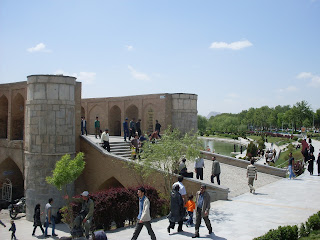Tuesday, 6 April 2010
I finally found the images I had developed in my head about Iran by reading about this region of the world and the country in Isfahan Iran is Isfahan Isfahan
Its climate and weather are nice. It is a nice, habitable city. It is quite orderly and clean. It is full with the refined artwork and architecture left behind by the Safavids. The Selcuks also had a lot of contributions in Isfahan
The artworks were mostly damaged during the Kachars and the revolution. During the revolution, people took their anger and hatred against the kingdoms by damaging and breaking the artwork in the Safavid palaces. Pity. After the revolution, the names of most monuments and squares were changed to "imam."
In this country, they care more about what the imams say rather than God and the prophets. They don't pray in the mosques. They only pray there on Fridays.
Since the time we arrived in Iran
Anyway, what's important is the architecture of the mosques in Isfahan, the intensity of the blue in all the tiles and paintings, acoustics that they could achieve, musical sound systems and even the animal figures they used on the tiles in the mosques (even though it is against Islamic art).
They really paid a lot of attention to refined motives and ornaments.
In the Safavid period, they even built an easily climbable minaret for a blind imam so that women who didn't want to cover their head could pray. How times have changed...The floors of the mosques are not even carpeted. Brick is heavily used in Iranian architecture.
Even these mosques have been constructed with brick and the bricks have been covered with tiles.
The river stemming from the mountains cools the city and gives a different atmosphere. It makes it a green city. There are 3-4 bridges on the river. The Hajou Bridge
The Safavid King, Shah Abbas the First's (the one who created the Shiite sect in Iran ) 40 Column Palace is one the three palaces which have survived to this day in Isfahan
But it is possible to see interesting mural paintings and decorations here. There are decorations which align with the fairytales and mythologies I have read as a child and the Persia

In these images, it is possible to see that the Safavid kings used to serve wine for their foreign guests.
It is also possible to see miniatures in this palace which depict the daily life of the time. There were also Dutch and English artists in the Shah's palace.
These artists painted images of the European life, kings, princes and princesses on the walls of the palace and also on the walls of the Ali Kapu Palace Naksh-i Jihan Square Iran : Isfahan Iran 's Istanbul is Isfahan
Interestingly, no one ever mentioned the famous Persian poet Omer Hayyam so far. Is it because of his penchant for wine? We did have a disappointment in Iran Iran Turkey
All photos, Copyright Travelogueress

























No comments:
Post a Comment